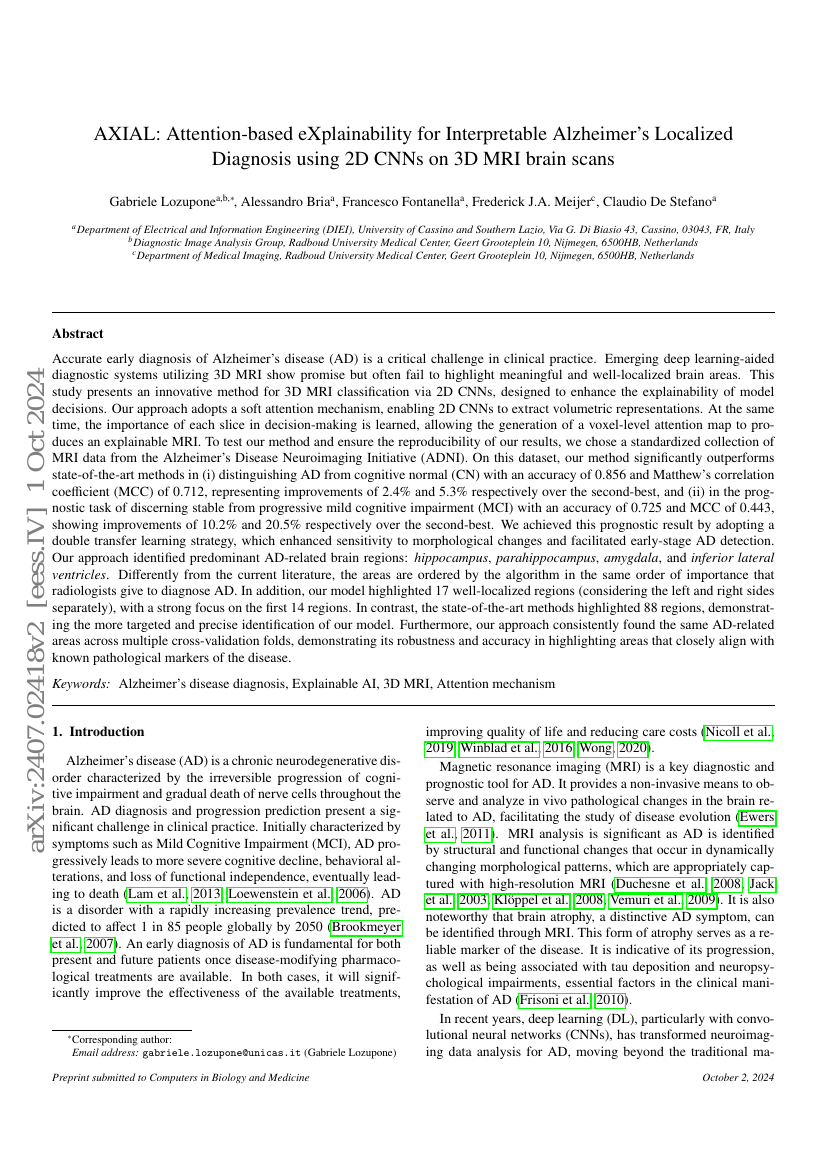Command Palette
Search for a command to run...
AXIAL: Attention-based eXplainability for Interpretable Alzheimer's Localized Diagnosis using 2D CNNs on 3D MRI brain scans
Lozupone Gabriele ; Bria Alessandro ; Fontanella Francesco ; Meijer Frederick J. A. ; De Stefano Claudio

Abstract
This study presents an innovative method for Alzheimer's disease diagnosisusing 3D MRI designed to enhance the explainability of model decisions. Ourapproach adopts a soft attention mechanism, enabling 2D CNNs to extractvolumetric representations. At the same time, the importance of each slice indecision-making is learned, allowing the generation of a voxel-level attentionmap to produce an explainable MRI. To test our method and ensure thereproducibility of our results, we chose a standardized collection of MRI datafrom the Alzheimer's Disease Neuroimaging Initiative (ADNI). On this dataset,our method significantly outperforms state-of-the-art methods in (i)distinguishing AD from cognitive normal (CN) with an accuracy of 0.856 andMatthew's correlation coefficient (MCC) of 0.712, representing improvements of2.4% and 5.3% respectively over the second-best, and (ii) in the prognostictask of discerning stable from progressive mild cognitive impairment (MCI) withan accuracy of 0.725 and MCC of 0.443, showing improvements of 10.2% and 20.5%respectively over the second-best. We achieved this prognostic result byadopting a double transfer learning strategy, which enhanced sensitivity tomorphological changes and facilitated early-stage AD detection. Withvoxel-level precision, our method identified which specific areas are beingpaid attention to, identifying these predominant brain regions: thehippocampus, the amygdala, the parahippocampal, and the inferior lateralventricles. All these areas are clinically associated with AD development.Furthermore, our approach consistently found the same AD-related areas acrossdifferent cross-validation folds, proving its robustness and precision inhighlighting areas that align closely with known pathological markers of thedisease.
Code Repositories
Benchmarks
| Benchmark | Methodology | Metrics |
|---|---|---|
| alzheimer-s-disease-detection-on-adni | AXIAL | Accuracy (5-fold): 85.6% MCC (5-fold): 0.712 |
| explainable-artificial-intelligence-xai-on | AXIAL | AD-Related Brain Areas Identified: hippocampus, amygdala, parahippocampal, inferior lateral ventricles |
| stable-mci-vs-progressive-mci-on-adni | AXIAL | Accuracy (5-fold): 72.5% MCC (5-fold): 0.443 |
Build AI with AI
From idea to launch — accelerate your AI development with free AI co-coding, out-of-the-box environment and best price of GPUs.